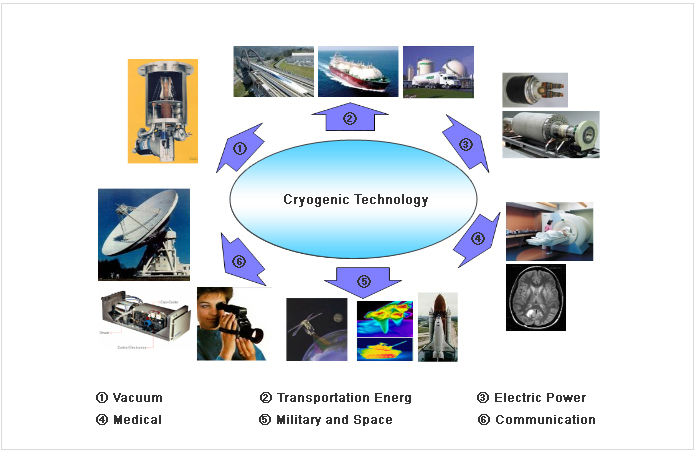
- >
- Superconductivity
- >
- Superconductivity Application Technologies
- >
- Cryogenic Cooling Technology
Cryogenic Cooling Technology
Cryogenic temperature is typically defined below 150 degrees (120 K), which is the boiling points of inert gases such as air, oxygen, nitrogen, neon, hydrogen, helium, etc.
Since HTS conductor shows unique characteristics of the superconducting phenomenon below a specific temperature, superconductors require cooling in order to maintain superconducting state.
Liquid Cryogenic Method
Use of cryogenic liquid such as liquid helium or liquid nitrogen
[Advantages]
When heat is generated in the superconductivity system due to the thermal disturbance, heat transfer accompanied with boiling of liquid is occurred at the surface of the superconductor. Thus heat transfer per unit area is very large and the saturation temperature of the liquid can be maintained constant under constant pressure. These effects lead excellent thermal stability.
[Disadvantages]
There are heat loss due to storage and transport of low temperature liquid. Cooling system efficiency is decreased due to the thermal load on cryogenic liquid vessels. Compact and lightweight of the system are difficult.
Conduction Cryogenic Method
Cooled to low temperature by contacting the object materials to the cryocooler cooled part directly or indirectly
[Advantages]
The superconducting system can be cooled by electric power without cryogenic liquid. Professional staffs for handling low temperature liquid and high pressure are not required. Heat loss due to the storage and circulation of the liquid can be reduced. Compact and lightweight of the system are possible. Flexible configurations of the system for the installation positions and angles are possible.
[Disadvantages]
In liquid cryogenic method, the temperature of the superconductor is basically constant at saturation temperature of liquid. However, in conduction cryogenic method, thermal stability is reduced because temperature is largely varied due to the cooling characteristics of cryocooler and the thermal characteristics of superconductor.
Cryogenic generation
Cryocooler, Low temperature liquid manufacturing .
Cryogenic Maintenance
High vacuum, Thermal insulation, Design and manufacturing of cryogenic vessel.
Cryogenic Transfer
Cryogenic heat exchange, Cryogenic pump and piping.
| Development Trends and their Levels |

